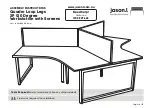
FLANGING MACHINE
13
F-200
3.3 THE USE OF THE MACHINE
T-DRILL F-200 is a flanging machine, the main purpose of which is forming the pipe end
into a 90º flange by means of a revolving spinning tool. This method is indicated for soft
steels (f.inst.St 35 DIN 17175), different copper alloys (f.inst. CZ110 BS 2871), stainless
steels (f.inst. AISI 316) and soft aluminium alloys. The flanging can be performed on cold
or hot pipe.
Cold flange forming
can be used for stainless steel, mild steel and copper alloys. Some
cases the tube needs a heat treatment to remove tension. With small diameters the
relative tube stretch may be 75%.
The wall thicknesses of the pipe to be used are: s=1,5…5-6mm.
Flange forming after preheating
is used for stainless steels. Before flanging, the pipe
end is preheated to 200ºC-300ºC, which prevents hardening of the material during the
flanging. The preheating may be done by means of the heating unit or else by heating the
pipe in another way before the flanging operation.
The wall thicknesses of the pipe to be used are: s=1,5…4-5mm
Hot flanging
is used for mild steels. The pipe end is heated to about 900ºC-950ºC, so as
to reduce the force required for the flanging. Moreover no further heat treatment after
flanging is then necessary. The heat treatment instructions regarding the material to be
treated must be observed.
The wall thicknesses of the pipe to be used are: s=3…8mm, depending on the
temperature of the pipe.
Flanging in two or three stages
is used for thin-walled pipes. First the flange is being
spinned the time set, after which it returns, preventing the pipe to wrinkle at the bending
radius of the flange.
Hereafter the forming pin continues the flanging operation until completed if no order for
a second return, i.e. a third flanging stage, is given.
3.4 METHODS OF FLANGING
3.4.1 COLD FLANGING
This is definitely the most efficient method due to its simplicity. However, in most cases,
annealing is required for stress relief after forming because, for example, with small pipe
dimensions the relative elongation may be up to 75 %. This is considerably greater than
obtained in tension tests, and results in hard and brittle structure.
Wall thicknesses: 2...5 mm for mild steel, stainless steel and copper alloys, up to 219,1
mm (8”) pipes. See chapter 6.3. Cold flanging and flaring of the pipe.
3.4.2. FLANGING AT RAISED TEMPERATURES
This method is used for austenitic steels. Before flanging the pipe end is preheated to
200...300 degrees centigrade, which prevents hardening during the flanging operation.
Wall thicknesses: 2...5 mm. Up to 219,1 mm (8”) pipes. See chapter 8. Hot flanging (and
flaring) of the pipe.
Summary of Contents for F-200
Page 1: ...F 200 FLANGING MACHINE INSTRUCTION MANUAL...
Page 97: ......














































